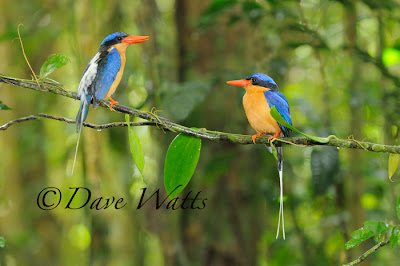At Mata Mata the endless dunes of the
Kalahari reach to infinity. We were camped atop a brick red dune just outside
the boundary of the Kgalagadi Transfrontier Park. This vast park covers
approximately 38,000 sq kms of arid country across the north western corner of
South Africa and the south west of Botwswana.
On the 7th April 1999 a
bilateral agreement was signed between South Africa and Botswana to agree to
manage their adjacent national parks as a single ecological unit. This become
the first Transfrontier Park to be formally declared in southern Africa. This
ambitious project has now resulted in several more such parks throughout Africa
and the world.
At first light, atop our dune, we gazed
across a dry river bed to where a lone White-backed Vulture stood proudly
silhouetted on its ramshackle stick nest on the flat crown of a Camelthorn Tree.
We watched entranced as a herd of Gemsbok padded silently past in single file
to drink at a nearby waterhole.
The dawn chorus of Laughing Doves,
Crimson-breasted Shrikes, hornbills and many other birds echoed across the
golden expanse while out of the emptiness a Lion roared to welcome the dawn.
We were certainly not alone as this near
desert environment was teeming with a diversity of life I have rarely
encountered elsewhere. Never have I seen so many visible birds nests in trees
and bushes. Many thorn bushes were covered in the grass ball nests of
White-browed Sparrow Weavers. Some Camelthorn Trees were collapsing under the
weight of the huge thatched condominiums built by hundreds of pairs of
industrious Sociable Weavers.
 |
| Sociable Weaver nest |
 |
| White-browed Sparrow Weaver at nest |
Strolling across our dune we could see the myriad tracks which spoke of the many nocturnal wanderings of solitary Springhares, Gerbils and Striped Mice. Scattered in the sand were a dozen Procupine quills banded in ebony and ivory.
As each day dawned upon entering the
National Park, we were treated to a succession of wildlife adventures. One
morning just after sunrise we stumbled across a Cheetah sat beside a sandy
track, tearing into a recently killed Springbok. A biologist studying the parks
Cheetah population informed us that an adult Cheetah needs to kill a Springbok
(or similar sized antelope) every 4 – 5 days.
We frequently saw family groups of
delightful Bat-eared Foxes intently feeding on the masses of termites.
Families of Ground Squirrels, Suricates
(Meerkats) and Yellow Mongooses were commonly encountered while the dry river
beds were traversed by wandering herds of Gemsbok, Blue Wildebeest, Red
Hartebeest and the ubiquitous Springbok.
The huge diversity of antelope and small
mammals provides food for top predators such as Lion, Cheetah, Leopard, Spotted
and Brown Hyaenas and Black-backed Jackals.
We were very fortunate to encounter the
regions majestic Black-maned Lions on several occasions. If solitude is what
you seek then try camping at the remote campground of Polenstswa, just a
stone’s throw across the border in Botswana. It was near here that we spotted
fresh Lion prints in the soft sand. We followed the tracks to a small dune
where 3 magnificent, male, black maned Lions were resting in the long grass.
The Kalahari skies are rarely empty and we
often watched dashing Bateleurs, rakish Lanner Falcons, majestic Tawny Eagles,
Gymnogenes, Pale Chanting Goshawks and many other raptors patrolling the blue
or perched motionless on a dead Camelthorn.
Sitting around our campfire I realised that
here I felt remarkably at home, while contemplating the approaching cold
Kalahari night.














